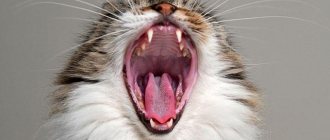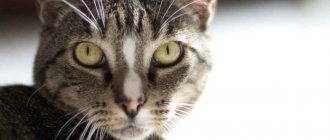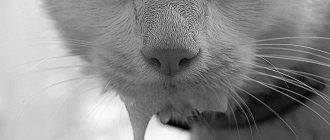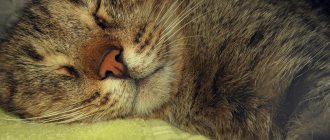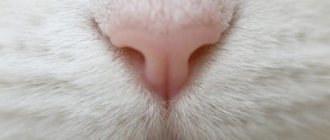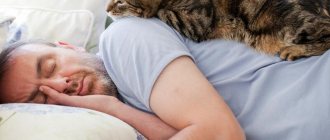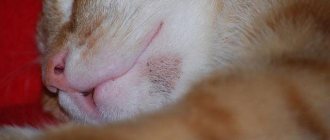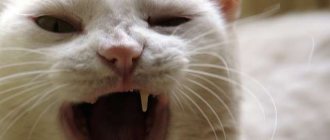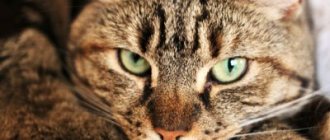Why does a cat's whiskers fall out, what to do and how. A cat's whiskers are falling out, causes of loss
What to do if your cat's whiskers fall out? If you notice that your pet's whiskers have begun to fall out, then you need to determine the cause of this condition as quickly as possible. Perhaps these are just physiological processes, or maybe the answer lies in a serious illness. Loss of whiskers in a cat is possible for the following reasons:
- lack of vitamins and minerals in the cat's body, in particular A, K, E and D. In parallel with the loss of whiskers, hair may begin to fall out, nails and teeth may break, and there will be an unpleasant odor from the mouth. Review your pet's diet and, if possible, replenish his body's supply with the missing components;
- lack of microelements, such as potassium, calcium, magnesium, silicon, zinc, selenium, copper, etc. In this case, problems in the functioning of the kidneys and liver are observed, pressure surges, insomnia, constipation, convulsions appear, diabetes mellitus develops, mustaches and hair fall out. Any of these symptoms are alarming and you should immediately contact a veterinarian;
- hormonal disbalance. The mustache begins to fall out, appetite decreases, and fatigue appears. The animal is trying to show with all its appearance that not everything is fine with it;
- skin diseases. Mycoscopy, dermatitis, notoedrosis and other problems with the epidermis lead to mustache loss. The problem is accompanied by severe itching, inflammation, redness;
- skin fungus. Trichophytosis and microsporia cause hair loss and mustache loss, among others;
- skin damage. Various injuries, wounds, cuts and abrasions can cause vibris loss;
- allergy. Fragility and loss of mustache occurs as a result of an allergic reaction to any food product or hygiene product;
- dry air. This is especially true in the cold season, when heating appliances are turned on in the house;
- fights. If there is more than one cat in the house, or when he likes to roam the streets, conflict situations may arise between him and other animals. During a fight, fighters lose their vibrissae;
- hypo- and hyperthyroidism. The latter most often affects older cats. Problems in the thyroid gland lead to hair and whisker loss, excess weight gain, weakness, loss of appetite, and decreased heart rate.
Mustache: briefly about the main thing
Let's figure out why a cat needs a mustache?
It is known that in a kitten in the embryonic stage, the first developing hairs are the vibrissae. This state of affairs is not accidental and is explained by the fact that it is the mustache that first of all helps the baby establish contact with the environment with which he is surrounded.
The whiskers send nerve impulses that are recognized by brain cells. The visual function of the eyes is carried out according to the same scheme. By summing up these signals, the cat perceives the world around it.
To answer the question of why a cat needs a mustache, let’s remember what a graceful animal it is. Its grace and maneuverability are also achieved thanks to the vibrissae. It is the “tactile hairs” that allow you to feel the direction of air flows, which is of considerable importance when making a jump, at the moment of falling and during normal movement. The information received by the vibrissae helps to avoid unnecessary injuries.
It is known that a cat's whiskers are very sensitive. For this reason, human touching them is not very pleasant for the animal.
The whiskers are capable of providing data that cannot be obtained using other senses. The difference between vibrissae and regular hair is that the vibrissae go much deeper into the tissue than regular hair. As mentioned earlier, “tactile hairs” have many nerve endings, thanks to which the animal receives a lot of information about the surrounding world.
Why does a cat's whiskers fall out and is it normal? A cat's whiskers are falling out - causes of loss
There are several reasons why a cat's whiskers fall out. If an animal behaves strangely, bumps into objects or shows anxiety, and the owner notices fallen or broken whiskers, the cause may be a pathological process developing in the body. The most common causes of whisker loss in cats are:
- Acute deficiency of vitamins and minerals in the body. Loss or increased fragility of the vibrissae occurs as a result of a lack of vitamins, especially fat-soluble ones - retinol and ergocalciferol. Fragility may also be caused by a lack of collagen in your pet's diet. In addition to the fragility of the whiskers, there are disturbances in the structure of the coat (dullness, loss), the claws peel off, and an unpleasant, repulsive odor can be heard from the oral cavity. The occurrence of such symptoms requires consultation with a veterinarian and diagnostic measures. It may be enough for your pet to adjust its diet by adding vitamin and mineral complexes to its main food.
- Thyroid gland dysfunction. Problems in the endocrine system always negatively affect the functioning of the entire body. One of these pathologies is hypothyroidism. This is a pathological process caused by decreased activity of the thyroid gland. Most often diagnosed in elderly pets due to a general slowdown in the body's metabolic processes. With hypothyroidism, the animal’s whiskers not only fall out, but seem to crumble. The coat also undergoes changes, the animal shows anxiety, appetite increases, and polydipsia (increased thirst) occurs. The pet may suffer from anorexia. Hypothyroidism can be characterized by dyspeptic disorders - eruption of gastric contents, profuse diarrhea. Self-medication in case of hypothyroidism can cause death of the animal, so it is recommended to consult a qualified doctor. This will allow us to assess the degree of neglect of the pathology, as well as develop an adequate treatment regimen.
- Pathologies of the skin. Skin diseases that arise as a result of fungal pathologies or the activity of pathogenic bacterial microflora, especially in the area of the pet's face, also provoke whisker breakage. Vibrissae can fall out in a cat if it is affected by notoedrosis or microsporia. This is due to the fact that the cat’s whisker follicle is located deeper than the hair follicle. In addition to the loss of whiskers due to a fungal or bacterial skin infection, symptoms such as itching and restlessness are observed. As a result of scratching the skin, wound surfaces are formed.
- Food allergic reaction. A food allergy in a cat provokes disruption of the internal organs. The skin and coat are primarily affected. Whiskers and hair fall out in the head area, with further scratching and the formation of crusts. It is necessary to eliminate the factor that provokes the allergy. A veterinary specialist will help carry out differential diagnosis and give recommendations for treatment.
- Injuries resulting from fights with relatives. Domestic cats constantly defend territorial boundaries. Therefore, fights between relatives occur quite often. In order to cause inconvenience to its opponent and show its superiority, the cat rips out the enemy's whiskers by the roots or bites them. If fights occur between two cats living in the same house, it is recommended to separate them, carefully monitoring the fights. Pets that do not have breeding value are recommended to be neutered.
A little anatomy
Whiskers, or vibrissae, are tactile, mechanosensitive hairs that differ from the rest of the fur in length, thickness and degree of stiffness. In all domestic animals, without exception, they are located on the muzzle (above the eyes, in the area of the muzzle and chin) and paws (on the back side), and in some privileged individuals, short vibrissae even decorate the nose.
All whiskers are connected to separate areas of the brain and help the cat determine its location in space, as well as sources of movement and sounds.
In ancient times, people believed that kittens with the longest and most luxuriant whiskers would certainly become excellent mousecatchers. These days, any cat owner can easily challenge this sign. Perhaps several thousand years ago the quantity and quality of whiskers was associated with the hunting abilities of animals. Unfortunately, it is impossible to verify this. In modern murkas, the length and thickness of the mustache depend on the same qualities of the hairline: the shorter the hair, the more modest the mustache will be; the longer and thicker, the more magnificent the whiskers decorating the cat’s face. As for the hunting qualities of our pets, cat owners can tell many stories about super mousecatchers with very modest mustaches and about cats with entire “bouquets” on their cheeks, who have never caught a single mouse, even a small one, in their entire lives.
Owners of those animals whose noble noses are decorated with protruding antennae will certainly report that their pets are distinguished by extraordinary telepathic abilities. It's hard to say whether to believe this or not. Therefore, let’s leave this sensitive topic and take for granted the fact that cat whiskers are a unique tool for hunting, orientation in space and communication with both their relatives and mere mortals - us.
Video: Why does a cat's whiskers fall out?
Why does a cat's whiskers fall out? What to do? What to do if your cat's whiskers fall out
When owners of furry pets notice their whiskers have fallen out, first of all they should pay attention to their general condition. The manifestation of accompanying symptoms or deviations in the cat’s behavior is a reason to seek help from a veterinarian. One of the indicators that should worry a cat owner is intense loss of whiskers or their complete absence.
© shutterstock
Before making a diagnosis, the veterinarian conducts research and prescribes tests. Based on the results obtained, he draws conclusions about what caused the mustache to fall out. Depending on the diagnosis, the cat will be prescribed appropriate treatment. Its goal is to stop the loss of whiskers, eliminate the accompanying symptoms and cure the disease that caused the cat to lose its whiskers.
Having discovered why a cat's whiskers are falling out, the veterinarian will explain in detail to its owner what to do in this or that case. If a cat has lost its whiskers due to nutrition, it is prescribed a diet that excludes those foods that triggered the malfunction in the body. In case of allergies, the allergen is identified and eliminated. A possible reason for its appearance may be the shampoo used to wash the cat or the place where he sleeps. In the first case, the shampoo must be replaced with soap or chamomile infusion, in the second, the material of the cat bed must be changed. Areas affected by allergies should be wiped with antiseptic solutions. If a cat is diagnosed with a malfunction in the endocrine system, the veterinarian will prescribe medications and diet.
Normal for mustache loss
If a cat's whiskers fall out, this is not a reason to panic. First of all, you need to take a closer look at its behavior and see if a new whisker grows in place of the fallen whisker.
Most often, mustache loss is not associated with any abnormalities. Regardless of the molting period, they can be periodically renewed - old vibrissae fall out, and new ones appear in their place. The reason why a cat's whiskers fall out can be a fight with another animal or excessive curiosity, in which he comes too close to a burning fire.
What to do if your cat's whiskers fall out and why. Why does a cat's whiskers fall out?
Sometimes, when cleaning their apartment, cat owners notice their four-legged pet's whiskers falling out. If this phenomenon is isolated, then there is nothing to worry about, but if it repeats periodically, then this is a reason to show the animal to the veterinarian, since fallen whiskers may indicate problems in the cat’s body.
What are vibrissae
Cat whiskers (scientifically called vibrissae) are hard and thick whitish hairs. In cats, this is the organ of touch. They grow in groups: the longest ones are located above the upper lip, they are the most sensitive. Under the eyes, on the chin, in the cheek area they are shorter and less sensitive. Vibrissae are also scattered throughout the body and are present on the ankles and pads of the paws.
Thanks to the whiskers, the cat has the ability to navigate in space, perceive changes in air humidity and changes in atmospheric pressure. Even if she is in a dark room, she perfectly understands her location. A completely blind animal with developed and preserved whiskers exists comfortably in its environment.
The fact is that from the vibrissae, equipped with blood, nerve endings go directly to the trigeminal nerve. It is for this reason that the organ of touch is triggered even by a slight vibration in the air and sends a danger signal to the brain, and the brain, in turn, draws a three-dimensional picture of the surrounding world.
Acquaintance with a new object or person for cats always begins with feeling and sniffing. At this moment the animal looks very funny: the mustache moves forward, puffs up, the nostrils move. This way it collects as much information as possible about an unfamiliar object.
To understand the principle of action of the whiskers, just touch the tip of the cat’s nose with your finger - she will instinctively close her eyes. This happens because the animal is afraid of harming itself - the self-preservation reflex is triggered.
Mother Nature endowed cats with this wealth so that they could protect themselves from various obstacles when hunting in the dark (bushes, branches, grass), crawl through narrow cracks, using vibrissae to estimate the area of the opening, measure the speed and direction of the wind, which affects the direction and strength jump.
Vibrissae, in addition to performing protective functions, are an indicator of the animal’s mood. An aggressive cat tries to press its whiskers to its muzzle, while a friendly and affectionate pet has its whiskers directed forward.
It is precisely because of the presence of vibrissae on the body that the cat will resist if the owner begins to stroke it against the grain. When rubbed, she will feel a negative electrical charge, which causes her to experience negative sensations.
Causes of whisker loss in cats
The question of why a cat's whiskers fall out worries many owners, especially if the animal is accompanied by lethargy, confusion, and disorientation in space.
The most common causes of vibrissae loss:
- Lack of vitamins, in particular A and D, microelements, collagen. Most often observed due to the same type or unbalanced diet of the animal. It may be accompanied by extensive loss of fur - tufts on the back, withers, belly, as well as the appearance of bad breath and a change in the color of the claws. In this case, the feeding principle should be adjusted and foods enriched with vitamins and microelements should be added to the food.
- Fungal diseases that affect the neck and face of a cat. Parasitic and fungal spores lead to profuse hair loss and whiskers in the affected areas. One of the characteristic symptoms of the disease is severe itching.
- Hormonal imbalance, hypothyroidism. It most often affects older cats and affects not only life support processes, but also internal organs. It is expressed in the cat’s behavior - excessive activity or, conversely, lethargy, as well as hair loss, increased thirst and appetite, which is accompanied by a set of extra pounds. Treatment is prescribed by a doctor after examination, tests and diagnosis.
- Allergy to food causing hair loss. Food intolerance to certain foods often leads to inflammation of the skin on the cat’s head and the formation of a crust. Failure to “calculate” the provoking factor in time and failure to eliminate it from the diet can lead to disastrous consequences: accumulating in the intestines, allergens will inevitably lead to intoxication of the body. It is recommended to periodically make adjustments to the diet and monitor the effect of one or another component on the pet’s health. Dietary products should be included in the menu only after consultation with a specialist.
The loss of whiskers should be understood not only as a pathological loss, but also as a natural change of whiskers. If hair loss is a consequence of wear and tear, then do not worry - new hairs will certainly grow in place of naturally falling hairs.
Why does a cat's whiskers fall out? It cannot be ruled out that a pet may lose its whiskers during a fight in order to show ownership of its territory and advantage over its opponent.
Sometimes the mother gnaws off the antennae of the naughty offspring so that the babies do not act out and spend most of their time in their nest. It is not uncommon for a kitten to get too close to the fire. Naturally, a lost antennae is a natural occurrence for an inquisitive mischief-maker.
Without vibrissae, the animal, of course, will not die, but orientation for it, especially in the dark, will be difficult.
What is the danger?
If this condition progresses, the animal will soon begin to have problems with coordination of movements.
Whisker loss is a serious problem for cats because they are important sense organs. If they fall out profusely, it becomes difficult for the pet to navigate in space, especially in the dark. His confidence decreases and problems with coordination of movements arise. Owners notice that the cat's gait changes over time. If a pet loses the ability to sense external objects, this can lead to its death.
Why does a Maine Coon's whiskers fall out? What is the reason?
Short whiskers on a cat are not always a reason to panic, because quite often this is a natural process established by nature, when, during the renewal period, the old whiskers fall off, and strong new ones grow in their place. Most often you can observe that the whiskers have fallen off in a breed of cat such as the Sphynx. Moreover, some types of hairless cats do not have whiskers at all from birth. But the Maine Coon, on the contrary, has a mustache that is a great asset, since its length can reach 18 cm. But broken whiskers in a kitten and an adult pet are not always considered the norm. There are several reasons for increased fragility and loss of vibrissae:
- Fungus. A mycotic infection inside the cat's body, leading to fragility of the tactile organ.
- Poor quality food. If there is insufficient supply of nutrients, the cat’s body weakens.
- Helminths. The presence of worms entails a deterioration in the condition of the pet's whiskers and overall health.
- Dry air. If the room where the animal lives has low humidity and the air is dry, the whiskers will fall out until the microclimate normalizes.
- Frequent bathing. A small part of cats like to be in the water, so for the rest it is stressful, as a result of which their antennae also begin to fall off.
- Skin parasites. Fleas and lice, which chew through the organ of touch at the very base, cause enormous damage to the cat’s body.
Often this phenomenon is caused by the actions of other pets living in the house.
If a cat's whiskers have fallen off on one side, then it is likely that this could not have happened without outside “help.” For example, other pets break a kitten’s whiskers, showing their superiority, or small children, showing interest in the protruding parts of the animal’s body, pull its whiskers. Broken vibrators in small cats can also be caused by the mother cat, who in this way makes it clear who is in charge in the house.
What to do?
First of all, you should review your pet’s diet and change the food or, as veterinarians advise, switch to human food, since natural products, in addition to being a source of useful elements, are easier to digest. But do not forget that the pet’s menu should be balanced and consist exclusively of fresh products. When the whiskers are broken and do not grow for a long time, the cat may need an additional complex of vitamins, but their administration should be done exclusively by a veterinarian.
Cestal will relieve the animal of helminthic infestation.
If helminths are identified, which also cause whiskers to break off, it is advisable to undergo a course of anthelmintic therapy using the following drugs:
- "Cestal";
- "Prasitel";
- "Quantum";
- "Prasitid";
- "Kanikvakntel".
If a fungal infection is suspected, one of the following medications is usually prescribed:
- "Amphotericin";
- "Potassium iodide";
- "Amoxicillin."
When cats have broken whiskers for a long time, a parasite may have settled on the pet’s skin
Do not hesitate to visit a specialized physician; it is important to identify the type of pest and the extent of damage as early as possible. You can give injections yourself or feed your animal pills, but only after the doctor prescribes the most appropriate medication and describes the correct use of it.
Sometimes external use of local drugs is sufficient, but in other cases complex therapy is required, including antibacterial drugs in the regimen.
Why does a cat's eyebrows fall out? Other causes of alopecia
In addition to subcutaneous mites, active hair loss in a cat in the eye area can be caused by unhealthy diet, taking certain medications, neoplasms (both benign and malignant), lichen, scabies, and genetic predisposition. A receding hairline appears near the eye and then appears in other parts of the body, most often in the abdomen, hind legs and ears.
The most common allergens that cause bald patches are cereals, sheep meat, and protein of plant and animal origin. If a nutritional (food) allergy is confirmed, then it is necessary to switch the pet to hypoallergenic food and the problem will immediately be eliminated.
© shutterstock
Also, in a cat, bald patches near the ears can occur due to psychological disorders, for example, due to severe stress or emotional overstrain. This condition is typical for a cat after moving, a change in climate, when another pet appears in the family (type and age do not matter) or at the birth of a child.
Sometimes hair loss near the eyes occurs in the postpartum period. Most often this is due to exhaustion of the body after giving birth and feeding kittens. In this case, to eliminate bald spots, the cat needs to be provided with adequate nutrition, as well as additionally given multivitamin complexes. It is especially important that such preparations contain vitamin B1, which normalizes the functioning of the nervous system.
If bald patches in the eye area are the result of hormonal imbalance and pathologies such as hypo- or hyperthyroidism, diabetes mellitus, adrenal hyperfunction, then the cat will experience frequent urination, sudden weight loss, or, conversely, the development of obesity (even though the cat’s diet will remain unchanged) , increased thirst.
Why do cats' whiskers fall out? Why does a cat's whiskers fall out or break?
A cat's whiskers (vibrissae) are an important organ that performs the function of touch. They are connected to nerve endings and are capable of transmitting certain signals to the animal’s brain. The vibrations of the surrounding world, which a cat can feel with its whiskers, allow it to navigate, determine safe routes or determine the temperature of food.
A cat's whiskers are not decoration, but an important sensory organ.
As a cat matures, it is characterized by a change of vibrissae, like baby teeth. All other cases where problems with the mustache are observed are caused by some kind of pathology. It is important to immediately determine the cause and stop the development of the disease.
Why do whiskers fall out in adult animals?
The reasons why an adult cat that has already gone through a scheduled change of whiskers may lose its whiskers are the following:
- Allergy. Whiskers may fall out due to an allergic reaction, which can be triggered by an insect bite, food or chemical exposure.
- Fungi and parasites. Helminths and fungi weaken the animal's body, as a result of which the whiskers may fall out or become brittle. Whisk eaters can also harm vibrissae by simply eating them.
- Lice eaters in cats are insects that feed on scales that peel off from the animal’s skin during its life.
- Dry air in the room where the pet lives. This is especially true when heating is turned on in apartments.
- Fights between pets. Multiple cats in a household, especially cats of the same sex, may fight. During fights, the mustache can break.
- An imbalance in nutrition leads to a weakened immune system, as a result of which the cat may lose its whiskers.
- Frequent water procedures. The problem may lie in the wrong choice of bathing product. For example, shampoo can cause dry skin and make your mustache brittle.
- Hormonal disorders. When an animal's thyroid gland doesn't work properly, it can cause hair breakage.
- Peculiarity of the animal's breed. For example, hairless cats lose their whiskers profusely. Hairless cats may not have whiskers at all.
- Dehydration. When an animal drinks little, it can threaten not only the loss of its whiskers, but also other pathologies.
Why do kittens' whiskers fall out?
A kitten may lose its whiskers due to the following reasons:
- adolescence (natural change of vibrissae);
- disturbances of mineral balance, vitamin deficiency;
- the presence of worms, fungi, parasites;
- careless play of family members (for example, children) with the pet;
- active games between kittens;
- establishing the authority of the mother cat, who herself bites the kittens’ antennae;
- excessive curiosity leading to unpleasant consequences.
I have had many cats that have given birth to kittens at different times. But I never had a chance to pay attention to their bitten mustaches. Although they say this is a fairly common phenomenon. But I am familiar with the loss of whiskers in cats when changing. I have a collection of these antennae (they were discovered during cleaning).
Features of alopecia areata in men
In most cases, men do not pay attention to increased hair loss due to short haircuts. Therefore, for a long time they arrive in confidence that everything is normal with their hairstyle, missing the first signs of alopecia areata. Only when it is impossible not to notice the disease - bald spots appear on the head - do they begin to sound the alarm.
Doctors have not yet figured out the exact reasons for the occurrence of the nesting form. Different chronic diseases and pathological conditions lead to hair loss in different patients. But the result is the same - hairless areas of round or oval shape appear on the head. Along the edges of the bald spots, the hair is shortened, with broken ends. The skin in such places is reddish and appears inflamed.
The basis of the disease is damage to the hair follicles. Sometimes pathology is also observed on the nails. In addition to the scalp, other areas of the body are also affected. Eyebrows and eyelashes may noticeably thin, and hair on the chest or back may disappear.
Alopecia areata develops rapidly. Sometimes a week is enough for a completely hairless area to appear. It proceeds unevenly - stages of remission may alternate with relapse periods.
Doctors note that alopecia areata is the most complex form of baldness. It is difficult to treat as it is associated with chronic diseases. Often the only treatment option is hair transplantation. But this path is not a guarantee that new outbreaks will not appear in the future.
Men of different age groups are susceptible to pathology. There are 4 types of nested forms of baldness:
- in men from 20 to 40 years old.
The most common type. With treatment, hair is restored within 6 months. Complete baldness rarely occurs; - in children
. Occurs in 10% of patients. The disease progresses for a long time and can take up to 10 years. Hair return is slow and difficult, taking more than a year. The result of the pathology can be complete baldness; - age up to 20 years
. The rarest type. It is developing rapidly. In half of the cases it threatens complete hair loss; - in men over 40 years of age
. Develops slowly. Complete baldness occurs extremely rarely.
A connection has been noted between the appearance of the nesting form and hair color - brunettes suffer from it more often than blondes.
